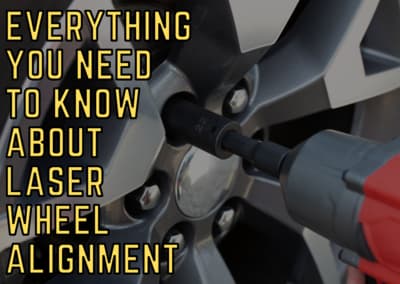Everything you need to know about laser wheel alignment

In this day and age, new and innovative technology has made it easier and more convenient to perform previously difficult tasks. This is also evident when it comes to the motor world. Due to a constant stream of new technology, car maintenance and repairs are becoming less of a headache and something that can be completed with minimal manpower and effort. One area that has seen this improvement due to new technology is wheel alignment. Thanks to the use of lasers this process has never been more precise and effective. In this article, we are going to inform you about everything you need to know about laser wheel alignment.
What is laser wheel alignment?
Laser wheel alignment may sound like a task that is very technical, however, it is actually a very simple process. The way it works is by using laser precision to align the wheels to their most optimum position. The lasers are used in an overhead projector, with a laser is projected on each wheel. By using a scale, a mechanic can see what angle the wheels are currently facing and can align the wheels accordingly to the perfect position.
What is checked during laser wheel alignment?
There are some technical terms for what is checked during a laser wheel alignment –
Toe
Toe is the direction and the angle that the front two wheels are pointing relative to each other.
Camber
Camber represents the vehicle angle of the wheel. If the wheel is leaning vertically toward the wheel arch, this is called negative camber.
Caster
Caster shows the angle of the steering axis, and whether it is tilted forward or backward from a side view.
Signs that your car needs a wheel alignment
There are some tell-tale signs that your car may need a wheel alignment -
Related: Why does my steering wheel vibrate?
Causes of wheel misalignment
Now that you know the tell-tale signs that your wheels need aligning, it is important to know the cause to avoid this in the future.
- Recently changed your tyres
- Hitting obstacles in the road, such as curbs and potholes
- Worn parts due to general wear and tear
What is Tracking?
When on the subject of wheel alignment, you may have heard another phrase for this called tracking. Tracking is just another word for wheel alignment and involves all the same checks as a laser wheel alignment.
How often should you get your wheels aligned?
It is recommended that you get a wheel alignment at least once a year. However, if you notice one of the signs that your car may need a wheel alignment, it is essential that you get this checked as soon as possible. This is because it not only has a detrimental effect on the performance of your car but can also put yourself and other drivers at risk.
Where can I get my wheels realigned?
At National, we offer three different wheel alignment services.
Front Wheel Alignment
We will adjust if required, the front toe adjustment back to the manufacturer's original settings with our laser aligning equipment.
Rear Wheel Alignment
Extend your tyre's life and ensure road safety with our high-definition digital rear wheel adjustment to ensure precision alignment.
Four Wheel Alignment
Front and rear axle digital tracking with toe adjustments only included to ensure complete accuracy for your entire vehicle.
To book your vehicle in for a wheel alignment at your local National Tyres and Autocare branch please click on the link below.
Related: Locate your nearest branch
Did you enjoy this blog post? |6 people found this review helpful



 Sign up for SPECIAL OFFERS
Sign up for SPECIAL OFFERS
